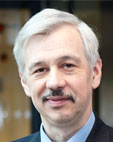
Michael Gasik
Michael Gasik is a full professor in Aalto University Foundation, School of Chemical Technology, Espoo, Finland (until 2010 – Helsinki University of Technology - TKK). He obtained his engineering degree in 1983 (special electrometallurgy), Ph.D. in 1987 (ferrous metallurgy), and two doctorates in 1995 (materials processing) and 2000 (composite materials). He also acted as visiting researcher and professor in Manchester University and UMIST (UK), Tohoku University Sendai (Japan) as well as supervising post-graduates in Estonia, Portugal, Slovenia, Japan, Belgium. The main activities of Prof. Michael Gasik are in the areas of materials processing and new materials solutions (basic metals, fuel cells, hydrogen, energy, biomaterials, tools, functional coatings, etc.) as well as their modelling and evaluation. The core competence is based on the chain "materials design - processing - structure - properties - testing - application" scientific research, management and modelling. One specific focus of research is in multi-objective design and optimization (MODAO) of materials, processes and phenomena (ab-initio and mathematical modelling combined with FEM, CFD and experimental validation) and data processing (visualisation, data mining, Bayesian analysis). He is a member of the editorial boards of several journals and has published over 180 referred articles and conference proceedings in various fields, plus 10 books and edited book chapters. He represents Finland in International Energy Agency Executive Committee (HIA) and novel biomaterials COST MP1005 action Management Committee.
The 5th Element - adding the life to CAE
Michael Gasik
Aalto University
Many biomedical - essentially biomechanical - CAE applications have been traditionally limited to a specific topic (biomechanical stress/deformation analysis for hard tissues or with CFD where fluid transfer is important). The solutions are being sought in the 4D domains (space-time) but the living matter contribution is only addressed to a little extent. This causes the major goal of the biomedical problem to be left aside, as the cells, their reactions, proliferation, differentiation and tissue formation with the whole life cycle evolution is missing. Many "engineering" data related to living matter functionality are not available and usually, when needed, being extracted from biological specimens leading to a high degree of scatter and uneven modelling output. New approaches such as ATMP require a high degree of confidence to avoid complications, but this confidence cannot be built on models with 99% guessed inputs. Extensive and expensive in vitro and animal in vivo tests, reported with a success, nevertheless fail in clinical trials by 80-95%. Here we are considering "the 5th element" - the life form evolution on cellular and tissue level - to be integrated into proper CAE models, aiming on the total objective No. 1: to live. Imposed constrains on the location or organism level allow "LifeCAE" to focus on specific problems and solutions, but this has to be backed up with relevant experimental and testing data, especially aimed in the alternative methods (not using animals - the "3R" directive). Some examples demonstrate the approach for specific cases and the new possible trends in LifeCAE are being discussed.